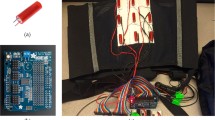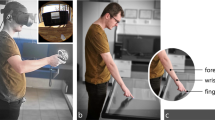Abstract
Vibrotactile feedback is an effective and economical approach for enriching interactive feedback. However, its effects are mostly limited to providing supplementary alarms or conveying the sense of simple object presence or contact. We propose to apply the “out of body” tactile illusion for selecting and manipulating a virtual moving object while also being able to feel its dynamics using two fingers. We assessed the user experience (focusing on the perception of the dynamics of the selected object) of the proposed method by comparing it to the conventional contact-based method. Our results indicate that users were able to perceive the dynamic feedback, and preferred it over the conventional method.
You have full access to this open access chapter, Download conference paper PDF
Similar content being viewed by others
Keywords
1 Introduction
Vibrotactile feedback is an effective and economical alternative to mechanically complex haptic devices. Despite its simplicity, it produces good results, especially when coordinated in a multimodal fashion with other associated feedback [1]. Still the effects are to mostly provide the sense of physical existence only. Therefore, it would be desirable for vibrotactile feedback to have the ability to express other aspects such as more dynamic interactions with objects (e.g., feeling a pulsating heart or holding on to a live animal). To achieve such a goal, we propose to apply an “out of body” tactile illusion. Funneling is one of the most notable illusory feedback techniques associated with vibrotactility [2]. Funneling can generate illusory tactile sensations by presenting two or more simultaneous tactile stimuli directly to two parts of the body. It is also possible to elicit a “moving” directional sensation by rendering successive funneling stimulations, which is also known as the “apparent movement” [3, 4]. Miyazaki et al. [5] discovered that a tactile illusion could be extended to “body connecting” objects and that it could create illusory sensations that from “out of the body,” e.g. as if coming from an object that is external to the user’s body.
Based on these illusion phenomena, we propose a two finger interaction method where two fingers “pinch” an object, and two vibration motors attached to the two tips of the fingers convey tactile touch/contact and directional object dynamics (see Fig. 1). The proposed method is comparatively assessed for its user experience (focusing on the perception of the dynamics of the object) through a user experiment.
2 Related Work
The mechanism most commonly used to generate hand-held tactile/haptic feedback has been employing small vibrating motors. These have been mostly used with mobile devices or hand-held game controllers to provide supplementary feedback for various interaction events (e.g., alarm, touch/key input, and virtual collision). Researchers have searched for ways to simulate other types of information by controlling the vibrating signal (e.g., texture simulation) [6] and by combining it with other modalities [7]. Nevertheless, vibrating motors are still inherently limited in terms of their ability to convey true haptic force, i.e., rigid contact as well as directional or inertial effects. Piezo-electric materials are another popular technology that is used for tactile feedback for mobile and hand-held devices [8, 9]. However, while this method is able to recreate static surface textures, e.g., protrusions and bumps, the devices lack features to provide more dynamic feedback.
A number of researchers have applied tactile illusion techniques to human interfaces [3, 4, 7, 10, 11] e.g. to minimize the number of tactile actuators (instead of using a comparable tactile array) [7] or to design vibrotactile feedback method that do not require direct contact to the fingers/hands. However, most of the prior tactile interactions have focused only on the providing feedback to indicate an existence of an object, the perception of texture patterns, and the outer shape of the object rather than its dynamics. In addition, illusion techniques have been usually applied to a continuous skin area rather than external to the body. Thus, applying the out of body tactile illusion seems one promising way to enrich the feedback while improving the general usability.
3 Experiment: Perception of Dynamics by Out of Body Tactile Illusion in Two-Finger Interaction
3.1 Experimental Set-up and Procedure
We demonstrate an application of “out of body” tactile illusion for two-finger object selection and manipulation and experimentally assesses whether the proposed method can bring about an improved user experience, when compared to conventional methods, by providing tangibility and sensation of the object and its interaction dynamics. Fourteen paid subjects, 10 men and 4 women with a mean age of 25, participated in the experiment.
An experiment with one-factor (3 feedback methods) within-subject with repeated measures was conducted. The task was to pick and hold a moving object (an animated fly) (Fig. 1). Both fingers were tracked using the Leap Motion sensor, and two conventional methods with no vibrotactile feedback (NF) and contact-only feedback (CF, nominal vibration given only for indicating contact with fingers) were compared to the proposed method (TI) where tactile illusion rendering was applied to the fingertips. No quantitative performance was measured, and only a questionnaire of the user’s experience was filled out (for the questionnaire categories, see Fig. 2).
3.2 Results
Figure 2 shows the average responses to the seven UX survey questions and the differences among the three feedback methods. In most categories (except for the “Fatigue” category), it is quite clear that the proposed method (TI) exhibited a much more positive user experience. Obviously, the NF condition scored the least in all UX categories. In fact, the Kruskal-Wallis test (non-parametric analysis) revealed that there existed statistically significant differences in all categories except for Q6 (Fatigue). A Tukey test using Ranks post hoc analysis showed that the proposed method had statistically significant effects over the NF and CF.
Note that to convey the feelings of object dynamics, providing only contact feedback (CF) at the respective fingertips would not be sufficient because the object may be moving at the mid-location without direct contact with the fingertips. The subjects also showed an overwhelming preference for the proposed method (TI) (out of 14 subjects, 13 for task). In summary, the experiment demonstrated that the interaction experience can be significantly improved through the proposed tactile illusion based rendering of the interaction object dynamics.
4 Discussion and Conclusion
In this paper, we have presented the possibility of applying an “out of body” tactile illusion to a two-finger object interaction in order to improve the user experience without causing significant fatigue. We strongly argue that the proposed tactile rendering of the object dynamics (and not just a multimodal fusion) was the contributing factor to the improvement in the interaction experience. The proposed method can be applied to many other interactive tasks, such as in tangible manipulation of augmented objects, interacting with holographic/stereoscopic virtual objects, surface computing, etc. Our future work will continue to develop and apply other illusion based techniques (including saltation) in a similar manner. One disadvantage of the proposed method is in its wearability. We are investigating whether the vibrators can be positioned and worn like a ring with similar effects.
References
Linjama, J., Kaaresoja, T.: Novel, minimalist haptic gesture interaction for mobile devices. In: Third Nordic conference on Human-computer interaction, pp. 457–458. ACM (2004)
Alles, D.S.: Information transmission by phantom sensations. IEEE Trans. Man Mach. Syst. 11(1), 85–91 (1970)
Israr, A., Poupyrev, I.: Tactile brush: drawing on skin with a tactile grid display. In: SIGCHI Conference on Human Factors in Computing Systems, pp. 2019–2028 (2011)
Seo, J., Choi, S.: Initial study for creating linearly moving vibrotactile sensation on mobile device. In: Haptics Symposium, pp. 67–70. IEEE (2010)
Miyazaki, M., Hirashima, M., Nozaki, D.: The “cutaneous rabbit” hopping out of the body. J. Neurosci. 30(5), 1856–1860 (2010)
Okamura, A.M., Dennerlein, J.T., Howe, R.D.: Vibration feedback models for virtual environments. In: IEEE International Conference on Robotics and Automation, pp. 674–679. IEEE (1998)
Hoggan, E., Anwar, S., Brewster, S.: Mobile multi-actuator tactile displays. In: Oakley, I., Brewster, S. (eds.) HAID 2007. LNCS, vol. 4813, pp. 22–33. Springer, Heidelberg (2007)
Poupyrev, I., Maruyama, S., Rekimoto, J.: Ambient touch: designing tactile interfaces for handheld devices. In: 15th Annual ACM symposium on User interface Software and Technology, pp. 51–60. ACM (2002)
Chubb, E.C., Colgate, J.E., Peshkin, M.A.: Shiverpad: a glass haptic surface that produces shear force on a bare finger. IEEE Trans. Haptics 3(3), 189–198 (2010)
Mizukami, Y., Sawada, H.: Tactile information transmission by apparent movement phenomenon using shape-memory alloy device. Int. J. Disabil. Hum. Dev. 5(3), 277–284 (2006)
Ooka, T., Fujita, K.: Virtual object manipulation system with substitutive display of tangential force and slip by control of vibrotactile phantom sensation. In: IEEE Haptics Symposium, pp. 215–218. IEEE (2010)
Acknowledgement
This research was supported by Basic Science Research Program (No. 2011-0030079) and International Research & Development Program (Grant number: 2014K1A3A1A17073365) through the National Research Foundation of Korea (NRF) funded by the Ministry of Science, ICT & Future Planning
Author information
Authors and Affiliations
Corresponding author
Editor information
Editors and Affiliations
Rights and permissions
Copyright information
© 2015 IFIP International Federation for Information Processing
About this paper
Cite this paper
Lee, J., Kim, Y., Kim, G.J. (2015). Applying “Out of Body” Vibrotactile Illusion to Two-Finger Interaction for Perception of Object Dynamics. In: Abascal, J., Barbosa, S., Fetter, M., Gross, T., Palanque, P., Winckler, M. (eds) Human-Computer Interaction – INTERACT 2015. INTERACT 2015. Lecture Notes in Computer Science(), vol 9299. Springer, Cham. https://doi.org/10.1007/978-3-319-22723-8_49
Download citation
DOI: https://doi.org/10.1007/978-3-319-22723-8_49
Published:
Publisher Name: Springer, Cham
Print ISBN: 978-3-319-22722-1
Online ISBN: 978-3-319-22723-8
eBook Packages: Computer ScienceComputer Science (R0)






